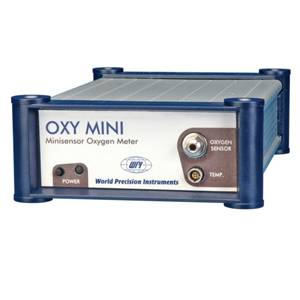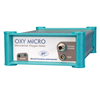

OXY-MINI-AOT
Fibre Optic Oxygen Meter for Minisensors
- Overview
- Specifications
- Accessories
- Citations
- Related Products
Overview

There are 1 images available to view - click to enlarge and scroll through the product gallery.
OxyMini Datasheet
/ Download as PDF
OxyMini Instruction Manual
/ Download as PDF
- Detection based on luminescence lifetime
- Excellent long-term stability
- Fast response time (< 0.5 sec for MicroTip sensors)
- Measurement is feasible in dry gas
- Immune to electrical and magnetic interference
Features
The OxyMini system is optimized for process control and biotechnology applications. The measurement principle of the sensor system is based on the detection of oxygen concentration as a function of luminescence lifetime either in dissolved or gaseous phase environments. The fiber optic oxygen meter is compact and easy to transport. It was designed for in/outdoor use and can be connected to a PC via a RS232 interface. Data can be visualized, analyzed and stored with the supplied software. A full range of sensors covering most biomedical applications are available.
Measurement Principle
Conventional fiber-optic oxygen sensor systems based on intensity measurements are limited in their accuracy by light source stability and ambient light fluctuations. Using a luminescence lifetime detection, measurements are not affected by light source stability, intensity fluctuations caused by fiber bending or changes of the optical properties of the sample (turbidity, refractive index, coloration, etc.). These advantages make WPI's OxyMini and OxyMicro the most advanced and reliable fiber-optic oxygen system available.
Calibration
The sensors can be calibrated by a simple two point calibration, 100% air-saturation and 0% air saturation.
Applications
The OxyMini is a single-channel fiber optic oxygen meter for WPI's fiber optic oxygen minisensors. These sensors are based on 2 mm polymer optical fibers and have a length of 2.5 m. A wide range of applications is possible with these sensors. Applications include:
- Process control: bottling plant in breweries and quality control of packages
- Biotechnology: Control of cell culture media and non-invasive control of bioreactors
- Implantation of oxygen sensors into soil and trees.
Specifications
Accessories
Citations
Lejeune, A., Frank, D., & Thonart, P. (2013). Physiological response of yeast to process perturbations: A mini-bioreactor approach. Cerevisia. Retrieved from https://www.sciencedirect.com/science/article/pii/S1373716313000383
Tsukada, K., Tajima, T., & Hori, S. (2012). Hypoxia-inducible factor-1 is a determinant of lobular structure and oxygen consumption in the liver. …. Retrieved from https://onlinelibrary.wiley.com/doi/10.1111/micc.12033/abstract





Request
Catalogue
Chat
Print